
WATER CRISIS IN IRAN
The theocratic regime in Iran is struggling to maintain its funding of proxy wars and terrorist groups throughout the Middle East, against a background of toughening US sanctions under President Trump’s ‘maximum pressure’ campaign and a grossly mismanaged attempt to control the coronavirus pandemic that has already cost over 112,000 lives. With the economy and currency in freefall, 70% of Iranians are now living on or below the international poverty line. The mullahs have stolen the people’s wealth for the past 41 years, corruptly lining their own pockets, financing terror and turning Iran into an international pariah, its religious fascist regime condemned for sickening human rights abuse. The Islamic Revolutionary Guards Corps (IRGC) – the regime’s Gestapo, controls over 80% of the economy, corruptly funnelling money stolen from the people into private banks and using the rest to finance their proxy wars and burgeoning nuclear and ballistic missile programmes. The IRGC pays no tax, nor does Ayatollah Ali Khamenei, Iran's supreme leader, who controls a financial empire worth an estimated $200 billion, resources which could readily be made available to alleviate the suffering of the Iranian people.
On top of all this, Iran now faces an ecological disaster. The mullahs’ maladministration over four decades has left Iran struggling with deforestation, desertification, water scarcity and countless other examples of environmental degradation. Climate change is exacerbating these environmental issues and turning them into a matter of life and death for the Iranian population. The deprived people living in southern, central and eastern Iran have witnessed the relentless destruction of their water infrastructure by the regime’s institutions, primarily the IRGC. The situation has become so bad that in Sistan and Baluchistan province in south-eastern Iran, people are being forced to collect rainwater from ditches and from crocodile infested lakes. In Lorestan, the CEO of the Water & Sewerage Company claimed that only half of the villages in his district are even linked to water and sewer systems. The MP for Ahwaz, in southwest Iran, claimed that 800 villages in his area had no access to drinking water, even although there were five large dams and seven rivers nearby.
Many dams have been constructed by the IRGC in the wrong places, preventing water from reaching towns and villages and causing drought in some areas and flooding in others. Farmers, deprived of a regular water supply are no longer able to irrigate their crops, creating food shortages. Meanwhile corrupt IRGC officials pocket the profits from selling potable water at outrageous prices to some of Iran’s poorest people. As always, when sporadic protests break out, the regime refuses to help, instead ordering the IRGC and Basij internal security thugs to crackdown on protesters and crush dissent, turning Iran into a volatile powder-keg, ready to explode.
Deforestation, which had been going on since 1900 when Iran enjoyed extensive forest-cover, accelerated after the mullahs came to power in the 1979 revolution. Nineteen million acres of trees in 1900, has shrunk to less than eleven million acres today. This has coincided with a sharp reduction in annual rainfall, caused partly due to deforestation and environmental degradation and partly to climate change, leading to desertification and water shortages. Alarmingly, Iran now ranks fourth in the World Resources Institute’s list of the countries at the greatest risk of exhausting their water supply. While dozens were killed by recent torrential rain storms and floods in Fars and Golestan Provinces, thousands more suffer from drought and water scarcity in other parts of Iran, where lakes, rivers and aquifers have dried up.
The mullahs’ response to the growing economic crisis has devastated Iran’s fragile environment. Determined to achieve self-sufficiency in agriculture and several other sectors, the theocratic regime ordered the felling of forests and draining of reservoirs, to create more available land for growing crops. The results were predictable, with environmental degradation accelerating and poverty and deprivation growing exponentially. Refusing to accept responsibility for these self-inflicted disasters, the mullahs turned their fury onto Iran’s dwindling community of environmentalists, arresting some of them on trumped-up spying charges. One environmentalist even died under mysterious circumstances in prison, while others fled abroad in fear for their lives.
One such notorious case involved the young, leading environmental scientist and water resources expert Kaveh Madani. President Rouhani coaxed him to leave his post at Imperial College London to join his government as the Deputy Head of the Iranian Environment Department and Deputy Vice-President of Iran. But from the moment he arrived in Tehran he was placed under constant surveillance by Iran’s Ministry of Intelligence & Security (MOIS) and was interrogated repeatedly. Finally, in February 2018 he was arrested by the IRGC and accused of espionage. Madani resigned from his political posts and fled to America, where he is now a Henry Hart Rice Senior Fellow at Yale University and spends a lot of his time drawing attention to the plight of his environmentalist colleagues in Iran.
It is this sort of prevailing paranoia in Iran that has hounded out those who could have helped the situation and forced a brain drain that has seen the majority of Iran’s best environmental scientists flee the country. As Iran creeps steadily closer towards ecological meltdown, environmental concerns have figured prominently in protests, particularly in regions populated by ethnic minorities like the Azeris and Iranian Arabs. Fearing such protests could spark a general uprising that could sweep them from power, the mullahs have reacted with typical viciousness, shooting dead unarmed protesters and arresting hundreds of others. But as water and food shortages grow, the Iranian population are becoming increasingly aware of the fact that their government is no longer capable of delivering basic public goods and services. The tipping point has been reached. Without adequate supplies of food and water, 80 million enraged Iranians will quickly lose their fear of batons and bullets.



